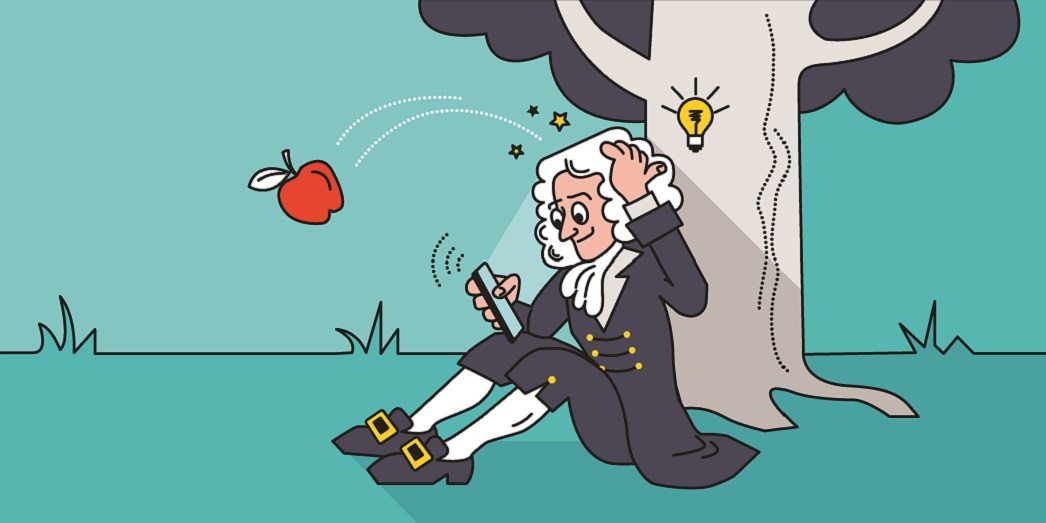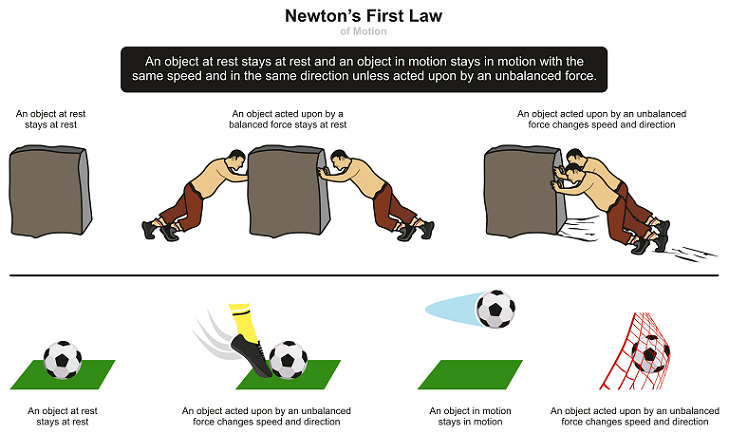
3 Newton’s laws with real-life examples for kids
Who is Newton?
What most people think about when they hear the name Newton is an apple that hit him while he was sitting under the tree thinking about physics. We are about to disappoint you as that did not really happen. But he still came up with so many brilliant ideas!
Isaac Newton is a 17th-century scientist. He can be considered one of the greatest scientific minds in the history of humankind. He devoted his life to science, putting his mental capacities at the service of humanity. What we take for granted now once was a mind-blowing discovery. He turned upside-down the perception of everyday things and made his contemporaries see the world differently. We are talking about Newton’s laws of motion, which are at the basis of the mechanics.
What are Newton’s Laws of motion?
Isaac Newton, as any scientist is supposed to be, was a very curious man. He would not take things around him for a given and started wondering and investigating what makes objects move.
That is how he thought up his three laws that describe the relationship between an object’s motion and the forces that make it move or stop. These three laws laid the foundation for Newtonian mechanics — a physical theory that describes the moving of visible objects of different sizes: from tiny ones to super huge as spacecraft, planets, and galaxies.
Let’s dive into these laws!
Newton’s First Law
Imagine you want to play soccer with your friends. To win or even start the game, one of your teammates has to kick the ball — otherwise, the ball won’t move by itself.
This is what the 1st Low implies:
Unless you push or pull (apply a force on) an object, it will remain at rest or in uniform.
Any type of force can be applied to it, and it does not necessarily have to come from a human. If the day you are playing football is very windy, a gust of wind can do the job and make the ball move.

A force in physics is a measure of the interaction of objects. A force makes an object change its speed (accelerate or even make an object stop) and its movement direction. When you kick the ball, it flies towards where you kick it — hopefully into a soccer goal. If the ball could choose the movement direction by itself, it would not be so fun to play soccer.
In reality, there are many types of forces in physics, and we will talk about them in other articles.
This law is also called the law of inertia.
Inertia in physics is an ability of an object to remain inactive or stable. If things did not have this tendency, our world would collapse into chaos. Just imagine the furniture in your bedroom sporadically moving by itself. It would be impossible or even dangerous to stay in such a space for a long time.
But thanks to this physical law, it remains where you put it, and you do not need to worry about waking up in your bed in a neighbor’s garden. Furthermore, if you decide to rearrange your bedroom furniture, you will need to apply some force to get it to budge.
However, this is only one aspect of inertia. Another one is that an object resists changes also while moving. Interestingly, before Newton’s discoveries, everybody in the world believed that it was natural for an object to stop moving at some point. As if a force applied to it to make it move will eventually run out, that is why the object would come to a rest position. Newton was the first man who opposed this general misconception.
He declared the opposite: it is a presence of a force that makes an object stop moving. This force is called the force of friction. But we will have to pick this up another time!
To sum up, this is how the main idea of Newton’s first law can be expressed:
Things do not start or stop moving or change direction independently without an outside force acting on them, which causes such changes in their movements.
You may think it sounds obvious as we are used to things being in a certain way around us. But that is the idea of physics — to describe and study all aspects of nature, the structure, and movement of things in the observable universe.
Newton’s Second Law — the fundamental law of motion
The second law states:
The acceleration of an object is connected to the force which is acting on it. The object speeds up due to the force acting on it.
As we found out before, an object starts moving because of the force acting on it. But how can we determine how fast it will move? Newton concluded that there are two factors the acceleration depends upon — the mass of the object and the force exerted on it.
How much an object will speed up directly depends on its mass and the amount of force applied to it.
This is why this law has a formula:
a = F / m,
in which:
- a — is the acceleration that is measured in meters per second squared (m/s2). It means that if an object accelerates at 1 m/s2, its speed is increasing by 1 meter per second every second.
- F — is a force that is measured in newtons (yes, he was so cool they named this unit of measurement in his honor)
- m — is an object’s mass that is measured in kilos.
Imagine you need to hit two different balls with a baseball bat: one is an ordinary baseball, and the other is heavier and bigger. Since balls have different masses, they will travel different distances and at different speeds when hit with the same force. If you increase the force of hitting, the less heavy ball will fly farther away. So the results will be different anyway.

You can also look at this law from a different perspective:
F = m × a
Newton wanted to say that to move faster a heavier object, you need to apply more force. Logically, the inertia of an object (its resistance to change) has also to do with mass. The more mass that a body has, the more inertia that it has and vice versa.
For example, think about how easy it is to move a book on a table and how much harder it is to move a wardrobe full of stuff! To do it, you may need to call a friend so that you can combine your forces.
Let’s see how we can use Newton’s second law of motion in practice!
How much force will it take to make a train which weights 5000 kilos move at 10 m/s2?
The formula we need to use to solve this problem is F = m × a.
We need to multiply the train’s mass (5000 kg) on desired acceleration (10 m/s2):
5000 × 10 = 50 000 newtons
The answer is: we need to apply 50 000 newtons of force.
Newton’s Third Law
If we want to use one word to describe this law, it is Karma. You get back as much as you give, and apparently, it is a physical law and not just a philosophical concept.
Newton’s Third Law declares:
For every external force, there is an equal force acting in the opposite direction.
What Newton means by it is that there are always two forces acting on each other at the same time in the opposite directions. And there are no isolated forces — it is a package deal. The first force comes from outside. The second one is the reaction on the first one, which acts back on the object exerting that force. These two forces are always equal, and in the end, they compensate each other.
This is the formula expressing Newton’s third law:
F1 = -F2,
where:
- F1 – is the force of the first object that acts upon the second object.
- F2 – is the force of the second object that acts upon the first object.
You will be surprised to know, but without this physical law, we will not be able to walk on the ground. Each step we make comes with force towards the ground. At the same time, there is a counter-force of the same size coming from the ground and pushing our feet upward. It helps us walk, run and jump.

The counter-force remains invisible. You probably do not even feel it as we are not used to paying attention to it. But if you know someone who has ever jumped off a tree or other higher ground, you probably heard him complaining about his foot pain afterward. That is exactly the result of the counter-force. If you hit the ground hard, it will hit you back as much. (So don’t jump off a tree.) It is the same reason why it hurts when you punch a punching bag, even though it feels quite soft when you just touch it.
In nature, a lot of things happen thanks to this physical law. Birds fly with the help of the counter-force produced as a response to them pushing the air downward. If the air were not pushing them back, they would have to try twice as hard and get tired faster. How would they be able to travel so far in search of the warm lands?
One of the conclusions that we can make from this law is that all forces result from objects’ interactions. While you are sitting in the chair reading this article, you are constantly pushing the chair with a downward force. Quid pro quo, the chair is pushing you back with an upward force. In nature, for every action, there is always an equal and opposite reaction.
Well, that’s about it! As you can see, physics is everywhere. It is continuously present in our life: in our every move and act. And what is fun about it is that you do not need to go to any special laboratory to experiment with its laws. What you can do now is to try to pay more attention to things happening around you and think which Newton’s law is behind it. You will start to notice their manifestations more and more in your life and everyday activity.
By the way, Newton was not only engaged in mechanics but also optics, chemistry, and other sciences. He was quite good at drawing and writing poetry. That is why many legends and unusual facts surround Newton’s personality. So being curious in life and trying out different activities eventually pays off.
Good luck with your discoveries, and remember that any problem can be solved!

new engaging articles



